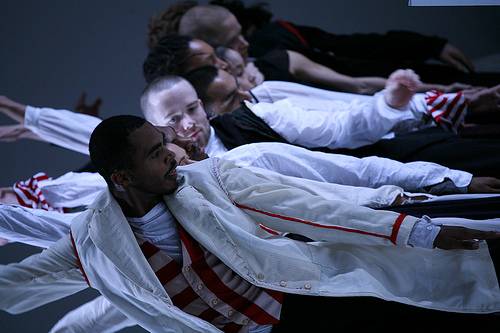FONDLY DO WE HOPE… FERVENTLY DO WE PRAY
The Bill T. Jones / Arnie Zane Dance Company
Wednesday, November 18
Krannert Center for the Performing Arts
Festival Theater
 Is the great social experiment of America still a melting pot of creativity and innovation? Or has 200 years turned it into motley crew with undirected propulsion?
Is the great social experiment of America still a melting pot of creativity and innovation? Or has 200 years turned it into motley crew with undirected propulsion?
This disruptive thought came vividly to mind at the overwhelming thunderball of theater and dance, “Fondly do we hope… fervently do we pray,” the commissioned work by the Bill T. Jones Arnie Zane Dance Company, which one critic described as “a work about mongrel America.”
At the least, there was an awful lot going on at the Festival Theater on Wednesday when the piece — commissioned by the Ravinia Festival to commemorate Abraham Lincoln’s Bicentennial — met with a variety of reactions.
In the parking lot, someone asked me, “Can you explain that to us?” (No.)
Heard in the lobby: “Well, that was something.”
Elsewhere, this exchange: “I wanted more dance.” “I wanted less clothes.”
The 90-minute piece — historical, poetic, musical, narrative, lyrical, episodic — builds to what seemed to be a required standing ovation. Not to comply might have seemed churlish, like turning your back during the Pledge of Allegiance. But the first hour sometimes was met with squirming, coughing, at least one cell phone eruption, and a couple of walk-outs. So much was going on, though, that none of these possible distractions seemed to matter. And by the end, at least to this reviewer’s eyes (and ears), there was a validated impact, if not a discernible cohesion.
The stage was filled with a high circular gauze, translucent oval curtains through which dancers could be seen or which could be drawn back to reveal the dancers and Greek columns behind. The movable columns could be aligned to represent the Lincoln Memorial, for example. Or, dancers would glide them along the floor in various combinations. We might be in ancient Greece or some futuristic fantasy. In fact, the narration took us from the Civil War to the idea of America as represented in the 22nd century. Sometimes, over it all, a video silhouette of a tall, walking Lincoln — or words written from an ancient scripture — filled the front of the scrim.
At least three times, there was the naming of body parts as a solo dancer appeared in a circular thrust stage on the right. (“Leg fibers, knee, knee-pan, upper-leg, under-leg…”). The first time, it seemed to represent humanity, the human body, itself, the American person. The second time seemed to be happening at a slave auction. And the third time, the implication that there was torture taking place, perhaps waterboarding at Guantanamo. This identification of the physical body with the country had impact. Also, it was an appropriate point to be made by a dancer and choreographer. Our bodies are what make America, America. Only later did I learn that this text came from Walt Whitman, that quintessential American, in his ode to human anatomy, “Poem of the Body.”
Other Americans dance out their stories on the thrust stage, while blues, gospel, and folk singers in the music pit performed a constant panoply of native song. (I heard comments later that the music was their favorite aspect of the performance.) One dancer moves while the narrator tells of him having received his GED and fought in Iraq, returning to a world that completely fails to understand him. The story of a single mother is told. Essayist Suzanne Carbonneau points out that yet another dancer in the piece seems to be revealing the life story of Bill T. Jones himself, “born in 1952”; “a family of fieldworkers”; “seven brothers and four sisters”; “a life in the theater”; “his great grandmother, he thinks, was born a slave.”
Indeed, the piece never can escape the notion of slavery. The piece is about Lincoln, after all, the “man who redeemed us from our foundational sin of racial slavery.”
Weaving through the phantasmagoria is the presence of Mary Todd Lincoln, walking in her widow’s weeds, haunting our history in sadness, mourning, loss, and obsessed with acquiring possessions, buying things she does not need. (Carbonneau says Mary Todd’s acquisitiveness is Jones’s “profound metaphor for our own unhinged age.”)
It’s a little jarring at the point when a crowd is shouting, “We’re here, it’s clear, get used to it,” which — although it rhymes with the chant from gay liberation actions — seems to relate to any group — immigrants, minorities, rebels of every shape and size — protesting for their rights within the great canvas of America. This diversity, too, was continually represented on the stage in the dress and appearance of the dancers. There is no consistency. Tall, short, sinewy, sizable, bearded, black, white, formally attired or in a wife-beater… the dancers displayed an egalitarian postmodernism of many shapes and sizes.
“But we still believe in great men and women…” the narrator said as the piece concluded, even though in Jones’s dramatic and fascinating display, it doesn’t seem to be necessarily true. In encompassing everything, the greatness becomes both universal and invisible, so that, in the end, “Lincoln is a story we tell ourselves.”








